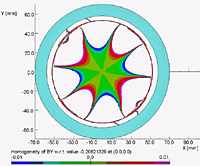Director's Corner
22 June 2006
 Barry Barish |
How Many Magnets Make a Linear Collider?
Magnets that steer beams around a ring-shaped accelerator, that focus particle beams and that make various optical corrections are key to building such high-energy particle accelerators. But, will magnets be so important for a linear collider, a particle accelerator that is conceived to be perfectly straight, or at most just bend enough to follow the Earth’s curvature? The answer is that magnets will again play important roles in the ILC, and our present baseline design calls for more than 17,000 magnets!
The ILC Reference Design magnet group, led by Ryuhei Sugahara (KEK), John Tompkins (Fermilab) and Eduard Bondarchuk (Efremov Institute), have started from the lattice magnet requirements for our baseline, in order to define the basic requirements for ILC magnet systems. They are working with each area group like the main linac, damping rings, beam delivery groups, etc. We have magnet experts working on conventional magnets, superconducting magnets, undulators, wigglers, kicker, septum, and pulsed magnets, and the associated power supply systems. There are some very challenging issues, including achieving performances that will preserve the beam size, maintain alignment, minimise stray fields, obtain sufficient reliability and minimise the costs.
 Field homogeneity in candidate shell type dipole magnet correctors for the ILC main linac |
One of the more difficult challenges will be to minimise magnet failures at a level that will enable reliable science operations. The problem is that the typical mean time between failures for water-cooled magnets at operating accelerators is about 1 million hours per magnet, a failure rate that is about a factor of 20 away from what will be needed for the ILC. Our magnet group is studying reasons for failures in present magnets and various possible improvements that could lead to low enough failure rate. This is a challenging engineering problem that must be solved without driving the costs up too much.
Another issue that was recently pointed out by our magnet group is that it may be very difficult to achieve the very small (~ 2 mrad) crossing angle at the interaction region. This is due to problems fitting the outgoing beam magnet systems into the overall design. Detailed design work will be required to try to find the best solution to this problem.
While developing the ILC design there will be both many magnets and many types of magnets, as well as a variety of challenges that we will need to confront. Our magnet group has made an impressive start by scoping what magnets will be needed. In addition, they are well on their way to making cost estimates and are beginning conceptual designs of the magnets.
-- Barry Barish